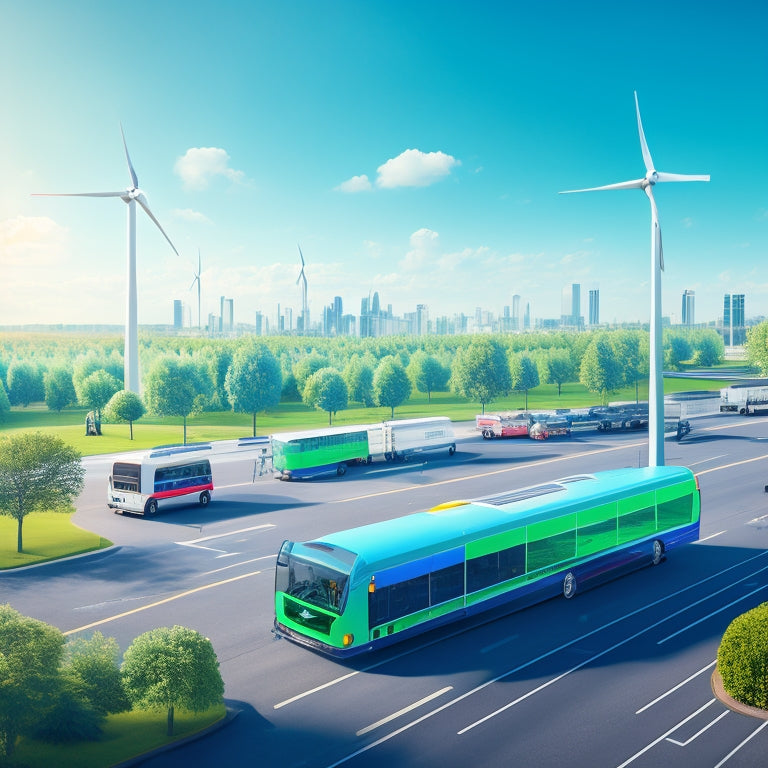
7 Best Ways to Electrify Your Fleet With Green Energy
Share
When electrifying your fleet with green energy, you'll want to explore seven key strategies. First, consider integrating solar panels into your EVs to reduce grid reliance. Next, implement green energy charging infrastructure, including energy hubs and smart charging systems. You can also incorporate renewable energy sources, like solar, wind, and hydroelectric power, into your fleet operations. Inverters will play an essential role in converting this energy into power for your EVs. Additionally, prioritize solar power for your charging station infrastructure and consider solar panel installation and maintenance. By adopting these strategies, you'll be well on your way to a sustainable, cost-effective fleet - and there's even more to discover.
Key Takeaways
• Integrate solar panels into EV fleets to reduce grid reliance and fossil fuel dependence, generating clean energy and lowering operating costs.
• Implement Energy Hubs with Smart Charging Systems and Grid-Scale Energy Storage to stabilize the grid and ensure reliable energy supply.
• Develop a renewable energy plan incorporating solar, wind, and hydroelectric power to minimize fossil fuel reliance and decrease greenhouse gas emissions.
• Properly size and install inverters to convert renewable energy into power for EVs, ensuring fleet safety and optimal performance.
• Prioritize safety and efficiency in charging station design, incorporating energy storage systems powered by solar power to ensure reliable energy supply and business continuity.
Solar Panels for Electric Vehicles
When integrating solar panels into your electric vehicle (EV) fleet, you can greatly reduce your reliance on the grid and lower your carbon footprint. By harnessing the power of the sun, you can generate clean energy and reduce your dependence on fossil fuels.
Vehicle integration of solar panels involves installing photovoltaic (PV) systems on your EVs, which can provide a supplementary source of energy to power your vehicles. This innovative approach to energy harvesting enables you to tap into free, renewable energy, reducing your fleet's operating costs and environmental impact.
As you integrate solar panels into your EV fleet, you'll also benefit from reduced greenhouse gas emissions, contributing to a cleaner, healthier environment. By embracing this cutting-edge technology, you'll be at the forefront of sustainable transportation, setting a new standard for eco-friendly fleet operations.
Green Energy Charging Infrastructure
You'll need to invest in a complete green energy charging infrastructure to support your fleet's shift to clean energy, ensuring seamless and efficient charging operations. This infrastructure is vital for maintaining grid resilience, which is essential for widespread electric vehicle adoption.
To future-proof your charging infrastructure, consider the following key components:
-
Energy Hubs: Centralized charging stations that can support multiple vehicles at once, reducing strain on the grid and increasing charging speeds.
-
Smart Charging Systems: Advanced charging management systems that optimize energy distribution, reduce peak demand, and provide real-time monitoring and control.
-
Grid-Scale Energy Storage: Large-scale energy storage solutions that help stabilize the grid and ensure a reliable energy supply.
- Microgrids: Localized energy systems that can operate independently of the main grid, providing backup power during outages and ensuring business continuity.
Renewable Energy for Fleets Today
As you shift your fleet to green energy, integrating renewable energy sources into your operations today can greatly reduce your carbon footprint and operating costs. By incorporating solar, wind, and hydroelectric power, you can minimize your reliance on fossil fuels and decrease greenhouse gas emissions. This not only benefits the environment but also helps you comply with evolving energy policy regulations.
A well-planned renewable energy strategy can also lower your energy expenditure, as the cost of renewable energy is becoming increasingly competitive with traditional fuel sources.
When developing your renewable energy plan, consider your fleet's specific needs and the local energy infrastructure. Identify areas with high renewable energy potential and explore opportunities for on-site generation or purchasing renewable energy credits. Additionally, stay up-to-date with government incentives and tax credits that can help offset the costs of shifting to green energy.
Electrify Your Fleet With Inverters
To efficiently harness the power of renewable energy, your fleet needs reliable and efficient power conversion, which is where inverters come in, playing an essential role in electrifying your fleet. Inverters convert DC power from renewable sources into AC power, making it possible to charge your fleet's electric vehicles.
Here are some key considerations when selecting and implementing inverters for your fleet:
-
Inverter Sizing: Make sure that your inverter is properly sized to handle the power requirements of your fleet, taking into account factors such as vehicle type, charging speed, and energy demand.
-
Fleet Monitoring: Implement a fleet monitoring system to track energy usage, monitor inverter performance, and identify areas for optimization.
-
Safety Features: Look for inverters with built-in safety features, such as overcurrent protection, ground fault detection, and surge protection, to ensure the safety of your fleet and personnel.
- Scalability: Choose inverters that can scale with your fleet's growth, allowing you to easily add or remove inverters as needed.
Solar Power for Fleet Operations
As you shift your fleet to solar power, you'll need to contemplate the charging station infrastructure that will support your vehicles.
You'll also want to ponder energy storage systems that can stabilize your power supply and guarantee a reliable flow of energy.
Charging Station Infrastructure
Your fleet's shift to electric vehicles relies heavily on the availability of efficient charging station infrastructure, which is where solar power comes in – a clean, renewable energy source that can greatly reduce your operation's carbon footprint.
As you switch to electric vehicles, it's crucial to take into account the design and implementation of your charging station infrastructure.
When it comes to station design, you'll want to prioritize safety and efficiency. Here are some key considerations:
-
Accessibility: Make sure that charging stations are easily accessible for all drivers, with clear signage and well-lit areas.
-
Urban planning: Strategically position charging stations near high-traffic areas, such as shopping centers or rest stops, to maximize convenience.
-
Station capacity: Choose charging stations that can accommodate multiple vehicles at once, reducing wait times and increasing efficiency.
- Safety features: Include safety features, such as emergency shut-off switches and fire suppression systems, to protect drivers and equipment.
Energy Storage Systems
By integrating energy storage systems powered by solar power, you can guarantee a reliable and consistent energy supply for your fleet operations, reducing dependence on the grid and mitigating the impact of potential power outages. This is especially vital for fleets that require a high level of uptime, such as emergency responders or delivery services.
Energy storage systems, comprising batteries and sophisticated battery management systems, ensure that excess energy generated by solar panels during the day can be stored and utilized during periods of high demand or when the grid is down. This enhances grid resiliency, reducing the likelihood of power disruptions and ensuring business continuity.
Effective battery management is critical to optimizing energy storage, as it enables real-time monitoring, efficient charging and discharging, and predictive maintenance. By leveraging energy storage systems, you can create a resilient and sustainable energy ecosystem that supports your fleet's operations while minimizing its environmental footprint.
Green Fleet Management Strategies
Implementing green fleet management strategies involves integrating sustainable practices into daily operations to reduce your fleet's environmental footprint. By adopting these strategies, you can minimize your fleet's impact on the environment while also reducing costs and improving efficiency.
To get started, consider the following green fleet management strategies:
-
Optimize routes and schedules: Use telematics and route optimization software to reduce fuel consumption and lower emissions.
-
Implement fuel-efficient driving practices: Encourage drivers to accelerate smoothly, maintain consistent speeds, and avoid idling to improve fuel efficiency.
-
Regularly maintain vehicles: Regular vehicle maintenance is essential to ensure efficient fuel usage and reduce emissions. Keep your vehicles in top condition by following a regular maintenance schedule.
- Monitor and analyze performance data: Use data analytics to track fuel consumption, emissions, and other key performance indicators to identify areas for improvement.
Harnessing Solar Energy for Fleets
As you explore ways to harness solar energy for your fleet, you'll need to take into account two essential aspects: installing solar panels and storing the generated energy.
You'll want to determine the best solar panel installation setup for your fleet's specific needs, taking into consideration factors like available roof space and energy requirements.
Solar Panel Installation
You can greatly reduce your fleet's carbon footprint by integrating solar panels into your vehicles, a move that not only benefits the environment but also cuts operating costs. This eco-friendly solution is becoming increasingly popular, and for good reason.
When it comes to solar panel installation, there are a few key considerations to keep in mind.
Here are some essential factors to keep in mind:
-
Roof requirements: Make sure your vehicles' roofs can support the weight and size of the solar panels. A sturdy roof is essential for a safe and successful installation.
-
Panel maintenance: Regularly clean and inspect your solar panels to ensure efficient energy absorption. A well-kept system will maximize energy output and reduce downtime.
-
Energy output: Take into account the energy output required for your fleet's operations. This will help determine the number and size of solar panels needed.
- Installation expertise: Collaborate with experienced installers who understand the unique requirements of fleet vehicles. This ensures a safe and efficient installation process.
Solar Energy Storage
With solar panels installed, your fleet's next step is to harness the generated energy efficiently, which is where solar energy storage systems come into play, allowing you to store excess energy for later use. This is important for guaranteeing a stable and reliable energy supply, especially during periods of low sunlight or high energy demand.
By incorporating solar energy storage systems, you'll be able to optimize your energy usage and reduce your reliance on the grid. This not only helps to decrease your carbon footprint but also provides grid resiliency, making sure that your fleet remains operational even during power outages or grid failures.
Proper battery maintenance is essential to ensure the longevity and efficiency of your solar energy storage system. Regular checks and maintenance will help prevent battery degradation, guaranteeing that your system operates at peak performance.
Frequently Asked Questions
How Do I Ensure a Stable Power Supply for My Fleet's Charging Needs?
To guarantee a stable power supply for your fleet's charging needs, you'll need to assess your energy demand, then consider upgrading your electrical infrastructure, investing in energy storage solutions, and potentially partnering with your utility to mitigate strain on the power grid.
Can I Use Existing Electrical Infrastructure for EV Charging Stations?
You can utilize existing electrical infrastructure for EV charging stations, but first, evaluate the grid capacity to make sure it can handle the increased load, and consider energy upgrades if necessary for safe and efficient charging.
What Is the Typical ROI for Investing in Green Energy for Fleets?
"When you take the leap into green energy, you'll be on a roll, reaping a typical ROI of 2-5 years, driven by cost savings, environmental benefits, financial incentives, and enhanced energy efficiency, making it a safe bet for your fleet's future."
Are There Any Government Incentives for Electrifying My Fleet With Green Energy?
You'll be pleased to know that yes, there are government incentives for electrifying your fleet with green energy, including tax credit benefits and grants, which can be accessed through a grant application process, making the conversion more affordable.
Can I Integrate Green Energy Solutions With My Existing Fleet Management System?
You can integrate green energy solutions with your existing fleet management system, ensuring system compatibility and seamless data integration, allowing you to track and optimize your fleet's performance and sustainability metrics.
Related Posts
-

7 Blockchain Tools for Home Energy Management
You can utilize blockchain technology to optimize your home's energy management through innovative solutions like blo...
-

10 Best Energy-Efficient External Hard Drives for Sustainable Offices
When it comes to sustainable offices, you need external hard drives that balance data storage needs with energy effic...
-

10 Powerful Electric Mowers for Expansive Lawns
You're moving away from gas-powered mowers and exploring electric options for your expansive lawn. You'll find that h...


